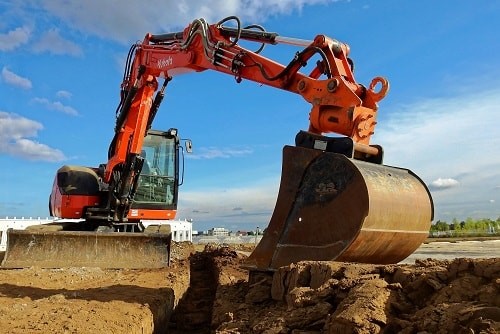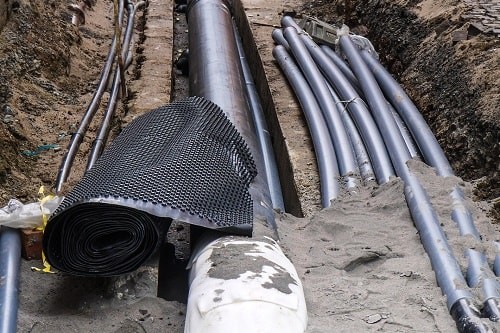A free service exists so those carrying out excavation work can check for potentially dangerous underground cables and pipes.
Features
Digging safely
Accidently striking an underground pipe or cable during digging work can have significant and long-lasting effects on the person involved, and those around them. It’s therefore essential that those involved in excavation work, and the UK public, fully understand the implications that come with hitting gas, water, oil and chemical pipelines or electricity and broadband cables, and know how to prevent this from happening.
The ramifications for health, safety and finances
71 per cent of all digging work that takes place in the UK is now preceded by a thorough search for pipes and cables through our portal, LSBUD.
LSBUD is a free-to-use online service that allows people – such as contractors, local authorities and ultility companies – to check for the presence of utility assets, such as underground and overground pipelines and cables carrying electricity, gas, water, fuel and fibre optic services, in the vicinity of their planned works. LSBUD holds records of hundreds of thousands of kilometres of utility assets in the UK, which are provided by asset owners who are members of its portal.
 71 per cent of all digging work that takes place in the UK is now preceded by a thorough search for pipes and cables through the LSBUD portal
71 per cent of all digging work that takes place in the UK is now preceded by a thorough search for pipes and cables through the LSBUD portal
However, according to our most recent Digging Up Britain report in 2019 there were still 1,230 safety-related electrical incidents reported to the Health and Safety Executive. Seventy three of these were injury-related. In addition, while gas-related incidents have steadily come down since 2013, there were still 1,248 reported in 2019.
There’s little doubt that the increased number of searches going through the LSBUD system has helped drastically minimise the dangers of such incidents, but there is still room for improvement. People need to remember that by undertaking work with limited, or no prior knowledge of what is beneath them, there is a real risk of injury, or even fatality.
While health and safety has to be the number one focus when it comes to avoiding pipes and cables being hit, there are other ramifications from such incidents. Underground assets need to be repaired when they’ve been hit and the indirect costs, such as traffic disruption and loss of custom to local businesses, have to be factored into that repair bill.
According to research by the University of Birmingham, the true cost of an asset strike is 29 times the direct cost; so, for every £1,000 of direct repair cost arising from a utility strike, the actual cost is £29,000.
As well as the human and financial impact, an asset strike can also result in considerable damage to the utility company. That’s because, irrespective of who’s responsible, disruption to any service affects customer perception, and thanks to social media, a complaint can quickly reach a mass audience.
Where are the dangers coming from?
In 2019, the LSBUD portal received 317,000 ‘emergency searches’, which was a 59 per cent jump on the previous year and 197 per cent up on just two years ago. If the searches going through our system are indicative of the work that’s taking place more widely, this is a key consideration for health and safety professionals as emergency projects are more likely to result in an asset strike of a more severe nature.
 In 2019 there were 1,230 safety-related electrical incidents reported to HSE. Photograph: LSBUD
In 2019 there were 1,230 safety-related electrical incidents reported to HSE. Photograph: LSBUD
Even though the LSBUD system delivers results in just five minutes, if a pipe or cable network is not registered on the portal, the firm doing the digging will need to deal with the asset owner directly. This can take up to 28 days, which I think everyone will agree is not a timescale that fits with the idea of an ‘emergency’. This leads to corners being cut, and assets hit, due to the need for speed. That for me is a significant health and safety concern.
In addition, the majority of digging work comes from the telecoms sector, with its contractors and operators completing 911,455 searches and making up 32 per cent of all searches in 2019. The water industry followed with 592,126 searches, accounting for 21 per cent of the total.
Searches from private individuals increased by 10 per cent and the system saw a 42 per cent surge in agricultural businesses making enquiries.
In order to keep all of these workers and the general public safe, it is crucial that those responsible for health and safety do two things. Firstly, they should champion the cause of sharing network information, encouraging all utility companies that are not currently sharing their information via the central portal to do so. Secondly, they should encourage thorough infrastructure searches for every job.
The solution
Simply put, having all asset owners on LSBUD’s central portal and anyone undertaking digging work searching the site before a spade or digger bucket hits the ground, could help avoid utility strikes and the serious injury risk they pose to those undertaking the work.
This would make the visibility of the UK’s underground pipes and cables network 100 per cent complete, meaning that as long as a search was performed before digging, there would be a much lower chance of mistakes being made.
Currently, LSBUD has just over 60 per cent of the utility providers in the UK as members, meaning circa 900,000 kilometres of the UK’s 1.5 million kilometres of underground pipes and cables are covered by the system. The remaining utility companies need to recognise that there’s protection by being part of the herd. The larger the number of asset owners sharing their information on the portal, the greater the number of searches every asset owner can appear in.
That being said, we are making significant progress, reaching a ‘tipping point’, both for the safety of the underground assets and those who dig near them. Asset searching on the portal has rapidly become second nature for people, with it now being a standard step in the vast majority of excavation projects. In fact, in 2019, there was a record 2.83 million searches through the portal, which equates to one search every 3.7 seconds during the average working day.
These numbers represent a big improvement in those responsible for doing the digging taking more accountability for their own health and safety. This is a message we have been championing for a sometime, so it is pleasing to see it starting to take hold.
For me, there is nothing more important than keeping people safe.
For more information, and the Digging Up Britain report, see: lsbud.co.uk
Richard Broome is managing director and founder at LSBUD
FEATURES

Underpinning safety training with neuroscience for long lasting impact
By SSE Active Training Team (ATT) on 30 November 2025
A behavioural safety training programme developed by Active Training Team for energy provider SSE has been carefully designed with neuroscientific principles in mind – resulting in a prestigious industry award for Best Training Initiative in 2024.

Why a painted line will never be enough
By UK Material Handling Association (UKMHA) on 20 November 2025
Businesses that operate material handling equipment like forklifts are being urged to submit accident and near miss details to a new confidential reporting portal so the industry can identify what needs to be done to improve safety standards.

Why workplace transport training is changing in 2026 and what it means for employers
By AITT on 26 November 2025
New workplace transport training categories due in January mean it is essential to ensure operators of material handling equipment have the necessary training for the exact type of machine they use, and accredited training providers are an ideal source of advice and conversion training.



